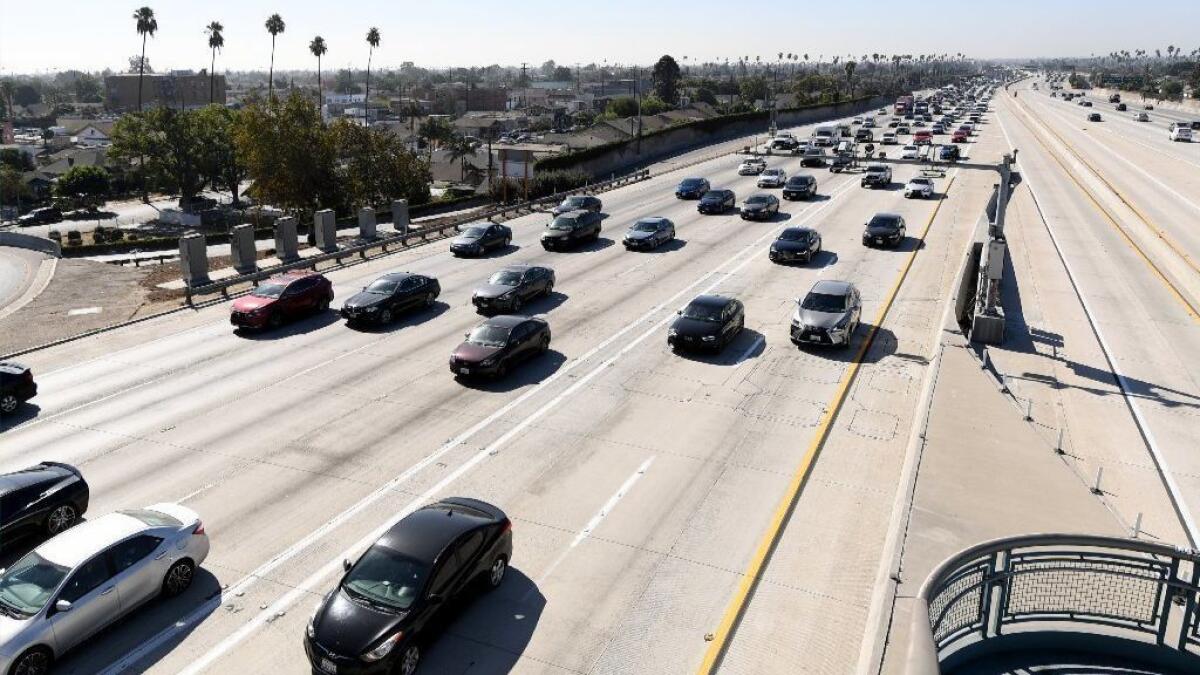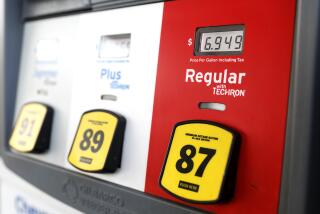Gas prices are dropping, just in time for Thanksgiving road trips

Southern California drivers have an added reason to be thankful next week.
When they hit the road for the Thanksgiving Day holiday weekend — one of the busiest driving periods of the year — they’ll find gasoline prices have dropped 15 cents a gallon or more, on average, from a month ago.
And pump prices are likely to fall further in response to a recent drop in crude oil prices, analysts said.
“California should see declines of around 20 cents a gallon over the next several weeks,” said Andrew Lipow, president of Lipow Oil Associates, an energy consulting firm in Houston.
Oil fell for a record 12 consecutive days on commodities markets — and suffered a decline of more than 20% from its recent high, entering what’s known as a bear market — before rebounding slightly Wednesday.
On Thursday morning, the benchmark West Texas intermediate crude oil for near-term delivery on the New York Mercantile Exchange rose 90 cents to $57.15 a barrel. A month ago, oil traded above $70 a barrel.
The recent high for oil came in early October, when oil and gasoline prices were on an upswing and mid-range and premium blends were priced at more than $4 a gallon at Southern California gas stations.
But then oil prices abruptly turned lower amid fears of excess supplies of crude and slowing worldwide growth in demand for oil.
That has lowered the average pump price for regular gas in the Los Angeles-Long Beach area to $3.707 a gallon from $3.882 a month ago, the American Automobile Assn. reported Thursday. Average prices for mid-range and premium blends dropped back below $4 a gallon.
The average for regular gas in all of California fell to $3.673 a gallon from $3.821 a month ago, the AAA said. The state’s record high price was $4.671, set in October 2012.
Patrick DeHaan, head of petroleum analysis at GasBuddy, which tracks fuel prices, expects prices to keep falling and recommended that Thanksgiving drivers wait to fill up until they get closer to the holiday.
“Motorists need not be in a hurry to fill their tanks” because the drop in oil prices “will extend and accelerate the declines seen at the pump, just in time for Thanksgiving,” DeHaan said on GasBuddy’s website.
Tom Kloza, global head of energy analysis at Oil Price Information Service, said further declines in gas prices are “as close to a guaranteed bet as you have,” given current market conditions.
“In California, I think it will be 25 cents [a gallon] and it happens just in time for the holidays,” he said.
The declines come as the AAA predicts 48.5 million Americans will drive 50 miles or more during the Thanksgiving period — from Wednesday through Sunday. That’s up nearly 5% from last year.
Thanksgiving travel overall, including plane travel, will climb 4.8% from last year to the highest level in 13 years, the auto club estimated.
Despite the latest drop in prices, gasoline in Southern California still costs far more than it did a year ago, when the average price for regular in the Los Angeles-Long Beach area was $3.293 a gallon. The national average a year ago was $2.564 a gallon.
The national average price for gas has plummeted nearly 23 cents a gallon in the last month, to $2.666 a gallon from $2.893, the AAA said.
Gasoline prices in California are higher than national averages because of the state’s unique blend of fuel to accommodate its strict environmental laws, which few refineries outside the state produce. In addition, California’s taxes are higher than those of most other states.
Part of the jump in California prices in the last year reflects a 12-cent-a-gallon increase in the state’s fuel excise tax that took effect in November 2017, bringing the state tax to 41.7 cents a gallon. The tax increase was intended to pay for road and bridge repairs and an expansion of mass-transit projects.
Critics of the higher tax tried to repeal it with Proposition 6 in the elections this month, but the ballot measure was defeated.
Until a month ago, oil prices had shot up more than $20 a barrel, or 39%, over the preceding 12 months after the Organization of Petroleum Exporting Countries and Russia agreed in late 2016 to restrain crude production and ease a global oil glut.
Prices also were lifted by President Trump’s decision this summer to reimpose sanctions on Iran, an OPEC member, which raised fears that Iranian oil exports would be curtailed. But the White House later softened the sanctions by granting waivers that allow certain countries to keep buying Iranian oil for now.
“The market was surprised when the strong rhetoric from the administration was countered with the granting of the waivers to eight countries, allowing Iranian oil sales to continue in excess of what the market anticipated,” Lipow said.
At the same time, “U.S. oil production has reached a new record, which, combined with Russia producing at a post-Soviet-era high as well as production increases from OPEC and non-OPEC members in anticipation of the Iranian sanctions, has led to an oversupply situation” and driven prices steadily down, Lipow said.
Twitter: @PeltzLATimes
UPDATES:
8:55 a.m.: This article was updated with details about California’s fuel taxes, Proposition 6’s defeat and an analyst’s comments on why oil prices have fallen.
This article was originally published at 7:20 a.m.







